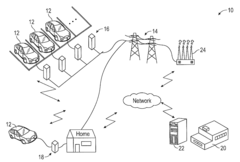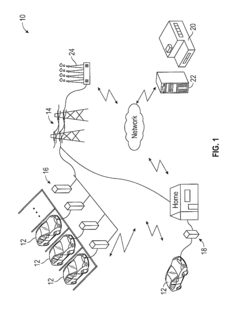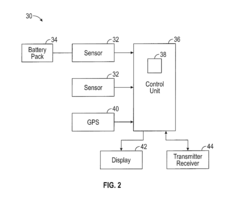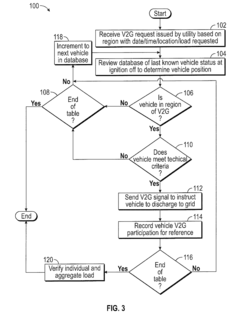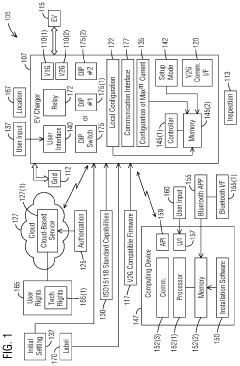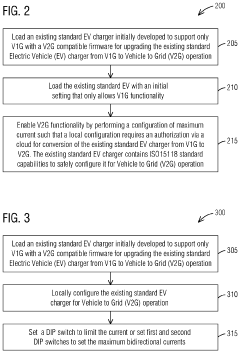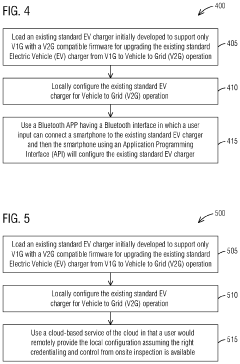How to Reduce Carbon Footprints with V2G Systems?
AUG 8, 20259 MIN READ
Generate Your Research Report Instantly with AI Agent
Patsnap Eureka helps you evaluate technical feasibility & market potential.
V2G Technology Evolution and Carbon Reduction Goals
Vehicle-to-Grid (V2G) technology has evolved significantly over the past decade, driven by the urgent need to reduce carbon emissions in the transportation sector. The primary goal of V2G systems is to leverage electric vehicles (EVs) as mobile energy storage units, enabling bidirectional power flow between vehicles and the electrical grid. This integration aims to optimize energy consumption, reduce peak load demands, and increase the utilization of renewable energy sources.
The evolution of V2G technology can be traced through several key milestones. Initially, the focus was on developing robust communication protocols between EVs and charging stations. This progressed to the creation of smart charging algorithms that could respond to grid demands in real-time. More recently, advancements in power electronics have enabled faster and more efficient bidirectional power transfer, significantly enhancing the potential of V2G systems to contribute to grid stability.
Carbon reduction goals associated with V2G technology are ambitious and multifaceted. One primary objective is to increase the penetration of renewable energy sources by using EV batteries as a distributed energy storage network. This approach helps to mitigate the intermittency issues associated with solar and wind power, thereby reducing reliance on fossil fuel-based power plants during peak demand periods.
Another critical goal is to optimize the charging patterns of EVs to minimize their carbon footprint. By incentivizing EV owners to charge during off-peak hours or when renewable energy generation is high, V2G systems can significantly reduce the carbon intensity of EV charging. Furthermore, by allowing EVs to feed power back to the grid during peak demand, V2G technology can help avoid the use of carbon-intensive peaker plants.
The long-term vision for V2G technology includes its integration into smart city infrastructures. This involves coordinating EV charging and discharging with other smart grid components, such as building energy management systems and renewable energy installations. The ultimate goal is to create a highly responsive and efficient energy ecosystem that can dynamically balance supply and demand while minimizing carbon emissions.
As V2G technology continues to mature, researchers and industry leaders are exploring ways to quantify and maximize its carbon reduction potential. This includes developing sophisticated modeling tools to simulate the impact of large-scale V2G deployment on grid emissions, as well as conducting real-world pilot projects to validate these models and refine implementation strategies.
The evolution of V2G technology can be traced through several key milestones. Initially, the focus was on developing robust communication protocols between EVs and charging stations. This progressed to the creation of smart charging algorithms that could respond to grid demands in real-time. More recently, advancements in power electronics have enabled faster and more efficient bidirectional power transfer, significantly enhancing the potential of V2G systems to contribute to grid stability.
Carbon reduction goals associated with V2G technology are ambitious and multifaceted. One primary objective is to increase the penetration of renewable energy sources by using EV batteries as a distributed energy storage network. This approach helps to mitigate the intermittency issues associated with solar and wind power, thereby reducing reliance on fossil fuel-based power plants during peak demand periods.
Another critical goal is to optimize the charging patterns of EVs to minimize their carbon footprint. By incentivizing EV owners to charge during off-peak hours or when renewable energy generation is high, V2G systems can significantly reduce the carbon intensity of EV charging. Furthermore, by allowing EVs to feed power back to the grid during peak demand, V2G technology can help avoid the use of carbon-intensive peaker plants.
The long-term vision for V2G technology includes its integration into smart city infrastructures. This involves coordinating EV charging and discharging with other smart grid components, such as building energy management systems and renewable energy installations. The ultimate goal is to create a highly responsive and efficient energy ecosystem that can dynamically balance supply and demand while minimizing carbon emissions.
As V2G technology continues to mature, researchers and industry leaders are exploring ways to quantify and maximize its carbon reduction potential. This includes developing sophisticated modeling tools to simulate the impact of large-scale V2G deployment on grid emissions, as well as conducting real-world pilot projects to validate these models and refine implementation strategies.
Market Analysis for V2G Systems
The Vehicle-to-Grid (V2G) market is experiencing significant growth as the world shifts towards sustainable energy solutions. The global V2G market size was valued at $1.8 billion in 2021 and is projected to reach $17.4 billion by 2027, growing at a CAGR of 48% during the forecast period. This rapid expansion is driven by increasing adoption of electric vehicles (EVs), growing concerns about carbon emissions, and the need for grid stability.
The demand for V2G systems is primarily fueled by the automotive and energy sectors. As EV adoption accelerates, the potential for V2G technology to provide grid services and reduce carbon footprints becomes more apparent. Major automotive manufacturers are increasingly integrating V2G capabilities into their EV models, recognizing the technology's potential to create additional value for consumers and utilities alike.
In the energy sector, utility companies are showing keen interest in V2G systems as a means to balance grid loads, especially with the increasing integration of renewable energy sources. V2G technology offers a solution to the intermittency issues associated with solar and wind power, providing a flexible and distributed energy storage network through EV batteries.
Geographically, Europe leads the V2G market, with countries like Denmark, the Netherlands, and the UK at the forefront of V2G pilot projects and implementations. North America follows closely, with significant investments in V2G research and development. The Asia-Pacific region, particularly Japan and South Korea, is also emerging as a key market for V2G systems, driven by government initiatives and technological advancements.
The market is segmented based on technology type, including unidirectional V2G and bidirectional V2G systems. Bidirectional V2G systems are gaining traction due to their ability to both draw power from and supply power to the grid, offering greater flexibility and economic benefits.
Key market drivers include government regulations promoting clean energy, increasing investments in smart grid infrastructure, and rising awareness about the environmental impact of traditional transportation. However, challenges such as high initial costs, lack of standardization, and concerns about battery degradation could potentially hinder market growth.
The competitive landscape of the V2G market is characterized by a mix of established automotive manufacturers, energy companies, and technology startups. Collaborations between these sectors are becoming increasingly common, as companies seek to leverage complementary expertise and resources to develop comprehensive V2G solutions.
As the market matures, we can expect to see more innovative business models emerging, such as V2G-as-a-Service, which could lower barriers to entry for consumers and accelerate adoption. The integration of V2G systems with smart home technologies and renewable energy systems also presents significant opportunities for market expansion and diversification.
The demand for V2G systems is primarily fueled by the automotive and energy sectors. As EV adoption accelerates, the potential for V2G technology to provide grid services and reduce carbon footprints becomes more apparent. Major automotive manufacturers are increasingly integrating V2G capabilities into their EV models, recognizing the technology's potential to create additional value for consumers and utilities alike.
In the energy sector, utility companies are showing keen interest in V2G systems as a means to balance grid loads, especially with the increasing integration of renewable energy sources. V2G technology offers a solution to the intermittency issues associated with solar and wind power, providing a flexible and distributed energy storage network through EV batteries.
Geographically, Europe leads the V2G market, with countries like Denmark, the Netherlands, and the UK at the forefront of V2G pilot projects and implementations. North America follows closely, with significant investments in V2G research and development. The Asia-Pacific region, particularly Japan and South Korea, is also emerging as a key market for V2G systems, driven by government initiatives and technological advancements.
The market is segmented based on technology type, including unidirectional V2G and bidirectional V2G systems. Bidirectional V2G systems are gaining traction due to their ability to both draw power from and supply power to the grid, offering greater flexibility and economic benefits.
Key market drivers include government regulations promoting clean energy, increasing investments in smart grid infrastructure, and rising awareness about the environmental impact of traditional transportation. However, challenges such as high initial costs, lack of standardization, and concerns about battery degradation could potentially hinder market growth.
The competitive landscape of the V2G market is characterized by a mix of established automotive manufacturers, energy companies, and technology startups. Collaborations between these sectors are becoming increasingly common, as companies seek to leverage complementary expertise and resources to develop comprehensive V2G solutions.
As the market matures, we can expect to see more innovative business models emerging, such as V2G-as-a-Service, which could lower barriers to entry for consumers and accelerate adoption. The integration of V2G systems with smart home technologies and renewable energy systems also presents significant opportunities for market expansion and diversification.
V2G Implementation Challenges
The implementation of Vehicle-to-Grid (V2G) systems faces several significant challenges that need to be addressed for widespread adoption and effective carbon footprint reduction. One of the primary obstacles is the current lack of standardization in V2G technology and protocols. This absence of unified standards creates interoperability issues between different electric vehicle (EV) models, charging stations, and grid systems, hindering seamless integration and scalability.
Infrastructure development poses another major challenge. The existing power grid infrastructure in many regions is not adequately equipped to handle bidirectional power flow, which is essential for V2G systems. Upgrading the grid to accommodate V2G technology requires substantial investments in smart grid technologies, advanced metering systems, and robust communication networks. This financial burden often deters utility companies and governments from rapid implementation.
Battery degradation concerns present a significant hurdle for EV owners considering participation in V2G programs. The frequent charging and discharging cycles associated with V2G operations can potentially accelerate battery wear, reducing the overall lifespan of the vehicle's battery. This concern needs to be addressed through improved battery technologies and compensation mechanisms to incentivize EV owners.
Regulatory frameworks and policy support are crucial yet often lacking for V2G implementation. Many regions have not established clear regulations governing the participation of EVs in grid services, creating uncertainty for both consumers and utility companies. The absence of supportive policies, such as feed-in tariffs or tax incentives for V2G participation, further impedes adoption.
Technical complexities in managing the dynamic nature of V2G systems present operational challenges. Balancing the grid while accounting for unpredictable EV charging patterns, varying energy demands, and fluctuating renewable energy generation requires sophisticated energy management systems and algorithms. Developing and implementing these systems at scale is a complex undertaking.
Consumer acceptance and behavior change represent significant social challenges. Many EV owners may be hesitant to allow external control of their vehicle's charging process or may not fully understand the benefits of V2G participation. Overcoming these perceptions requires extensive education and awareness campaigns, as well as the development of user-friendly interfaces and transparent compensation models.
Cybersecurity concerns also pose a critical challenge in V2G implementation. The interconnected nature of V2G systems creates potential vulnerabilities to cyber attacks, which could compromise grid stability or personal data. Ensuring robust security measures and protocols is essential but adds another layer of complexity to the implementation process.
Infrastructure development poses another major challenge. The existing power grid infrastructure in many regions is not adequately equipped to handle bidirectional power flow, which is essential for V2G systems. Upgrading the grid to accommodate V2G technology requires substantial investments in smart grid technologies, advanced metering systems, and robust communication networks. This financial burden often deters utility companies and governments from rapid implementation.
Battery degradation concerns present a significant hurdle for EV owners considering participation in V2G programs. The frequent charging and discharging cycles associated with V2G operations can potentially accelerate battery wear, reducing the overall lifespan of the vehicle's battery. This concern needs to be addressed through improved battery technologies and compensation mechanisms to incentivize EV owners.
Regulatory frameworks and policy support are crucial yet often lacking for V2G implementation. Many regions have not established clear regulations governing the participation of EVs in grid services, creating uncertainty for both consumers and utility companies. The absence of supportive policies, such as feed-in tariffs or tax incentives for V2G participation, further impedes adoption.
Technical complexities in managing the dynamic nature of V2G systems present operational challenges. Balancing the grid while accounting for unpredictable EV charging patterns, varying energy demands, and fluctuating renewable energy generation requires sophisticated energy management systems and algorithms. Developing and implementing these systems at scale is a complex undertaking.
Consumer acceptance and behavior change represent significant social challenges. Many EV owners may be hesitant to allow external control of their vehicle's charging process or may not fully understand the benefits of V2G participation. Overcoming these perceptions requires extensive education and awareness campaigns, as well as the development of user-friendly interfaces and transparent compensation models.
Cybersecurity concerns also pose a critical challenge in V2G implementation. The interconnected nature of V2G systems creates potential vulnerabilities to cyber attacks, which could compromise grid stability or personal data. Ensuring robust security measures and protocols is essential but adds another layer of complexity to the implementation process.
Current V2G Solutions
01 Carbon footprint assessment of V2G systems
Methods and systems for assessing the carbon footprint of Vehicle-to-Grid (V2G) systems, considering factors such as energy consumption, emissions during charging and discharging, and overall environmental impact. These assessments help in optimizing V2G operations for reduced carbon emissions.- Carbon footprint assessment of V2G systems: Methods and systems for assessing the carbon footprint of Vehicle-to-Grid (V2G) systems, including analyzing energy flows, emissions from power generation, and lifecycle impacts of electric vehicles and charging infrastructure. These assessments help quantify the environmental impact of V2G technology implementation.
- Optimization of V2G operations for reduced emissions: Techniques for optimizing V2G operations to minimize carbon emissions, including smart charging strategies, load balancing, and integration with renewable energy sources. These approaches aim to maximize the use of clean energy and reduce reliance on fossil fuel-based power generation during V2G interactions.
- Integration of V2G systems with renewable energy sources: Methods for integrating V2G systems with renewable energy sources such as solar and wind power to reduce overall carbon footprint. This includes energy management systems that prioritize charging from renewable sources and using V2G capabilities to support grid stability during periods of high renewable energy generation.
- Life cycle analysis of V2G infrastructure: Comprehensive life cycle analysis methods for V2G infrastructure, considering the carbon footprint of manufacturing, installation, operation, and end-of-life disposal of V2G components. This holistic approach helps in understanding the full environmental impact of V2G systems beyond just operational emissions.
- Carbon credit systems for V2G participation: Development of carbon credit systems and incentive mechanisms for V2G participants, rewarding behaviors that lead to reduced carbon emissions. These systems aim to encourage wider adoption of V2G technology and promote environmentally beneficial charging and discharging patterns.
02 Smart grid integration for V2G carbon reduction
Integration of V2G systems with smart grids to optimize energy flow, reduce carbon emissions, and improve overall grid efficiency. This includes intelligent charging schedules, demand response mechanisms, and renewable energy integration to minimize the carbon footprint of V2G operations.Expand Specific Solutions03 V2G system optimization for carbon neutrality
Techniques for optimizing V2G systems to achieve carbon neutrality, including advanced algorithms for load balancing, predictive maintenance, and energy management. These optimizations aim to maximize the use of clean energy sources and minimize carbon emissions associated with V2G operations.Expand Specific Solutions04 Life cycle analysis of V2G systems for environmental impact
Comprehensive life cycle analysis methodologies for V2G systems, considering the environmental impact from manufacturing, operation, and end-of-life disposal. This analysis helps in identifying areas for improvement in reducing the overall carbon footprint of V2G infrastructure.Expand Specific Solutions05 V2G carbon offset and trading mechanisms
Development of carbon offset and trading mechanisms specifically for V2G systems, allowing for the quantification and monetization of carbon reductions achieved through V2G operations. These mechanisms incentivize the adoption of V2G technologies and contribute to broader carbon reduction goals.Expand Specific Solutions
Key V2G Industry Players
The competition landscape for Vehicle-to-Grid (V2G) systems to reduce carbon footprints is in an early growth stage, with significant potential for market expansion. The global V2G market size is projected to grow rapidly, driven by increasing electric vehicle adoption and grid modernization efforts. While the technology is still maturing, several key players are emerging across the automotive, energy, and technology sectors. Companies like State Grid Corp. of China, Toyota, Honda, and Hyundai Mobis are investing in V2G research and pilot projects. Academic institutions such as Shanghai Jiao Tong University and South China University of Technology are also contributing to technological advancements. As the market develops, collaboration between automakers, utilities, and technology providers will be crucial for widespread V2G implementation and carbon reduction.
State Grid Corp. of China
Technical Solution: State Grid Corp. of China has developed an advanced V2G (Vehicle-to-Grid) system to reduce carbon footprints. Their solution integrates large-scale electric vehicle (EV) charging infrastructure with smart grid technology. The system utilizes bi-directional charging stations that allow EVs to both draw power from and feed power back to the grid[1]. This enables better load balancing and integration of renewable energy sources. State Grid's V2G system incorporates AI-driven predictive algorithms to optimize charging schedules based on grid demand and renewable energy availability[3]. They've also implemented blockchain technology for secure and transparent energy transactions between EV owners and the grid[5].
Strengths: Extensive grid infrastructure, advanced AI and blockchain integration, large-scale implementation capability. Weaknesses: High initial infrastructure costs, potential resistance from traditional energy stakeholders.
Hyundai Mobis Co., Ltd.
Technical Solution: Hyundai Mobis has developed a comprehensive V2G system that focuses on maximizing the efficiency of electric vehicle batteries in grid support. Their solution includes advanced battery management systems that allow for precise control of charge and discharge cycles, extending battery life while providing grid services. Hyundai Mobis' V2G technology incorporates AI-driven predictive maintenance, which can forecast potential battery issues and optimize performance[9]. They've also developed a unique "Vehicle-to-Everything" (V2X) platform that enables EVs to interact not just with the grid, but also with homes, buildings, and other infrastructure, creating a more holistic energy ecosystem[10].
Strengths: Advanced battery management technology, comprehensive V2X approach. Weaknesses: Primarily focused on Hyundai group vehicles, may require partnerships for wider adoption.
V2G Core Innovations
Priority based vehicle control strategy
PatentActiveUS20160075247A1
Innovation
- A method and system that prioritize V2G requests by determining which vehicles in a specific geographic region meet criteria established to reduce battery degradation, using historical and current data to select vehicles for participation, thereby limiting the number of charge and discharge cycles and extending the battery life.
Upgrading an existing standard electric vehicle (EV) charger from grid to vehicle (V1G) to v1g plus vehicle to grid (V2G) operation
PatentPendingUS20240201974A1
Innovation
- A method to locally configure existing standard AC EV chargers with ISO15118 capabilities for V2G operation by loading V2G compatible firmware, authorizing via the cloud, and configuring maximum current, allowing bi-directional charging/discharging through a communication interface.
V2G Policy and Regulations
Vehicle-to-Grid (V2G) systems have emerged as a promising solution for reducing carbon footprints in the transportation sector. However, the successful implementation and widespread adoption of V2G technology heavily depend on supportive policies and regulations. Governments and regulatory bodies play a crucial role in creating an enabling environment for V2G systems to thrive.
One of the primary policy considerations for V2G is the establishment of clear guidelines for grid integration. Regulatory frameworks must address the technical standards and protocols for connecting electric vehicles (EVs) to the power grid, ensuring safety, reliability, and interoperability. These standards should cover aspects such as communication protocols, power quality, and cybersecurity measures to protect both the grid and EV owners.
Incentive programs are another critical component of V2G policy. Governments can encourage V2G adoption through financial incentives, such as tax credits, rebates, or grants for V2G-enabled vehicles and charging infrastructure. Additionally, policies that allow EV owners to participate in energy markets and receive compensation for grid services can significantly boost the economic attractiveness of V2G systems.
Regulatory bodies must also address the complex issue of electricity pricing and tariff structures for V2G participants. Time-of-use pricing and dynamic rate structures can incentivize EV owners to charge during off-peak hours and discharge during peak demand periods, maximizing the grid-balancing benefits of V2G technology.
The development of a robust regulatory framework for V2G requires collaboration between various stakeholders, including utilities, automakers, charging infrastructure providers, and policymakers. Policies should promote open communication and data sharing among these entities to facilitate seamless integration of V2G systems into the existing power infrastructure.
Environmental regulations play a significant role in driving V2G adoption. Policies that set ambitious targets for carbon emissions reduction in the transportation sector can create a strong impetus for V2G implementation. Furthermore, regulations that recognize and quantify the carbon reduction benefits of V2G systems can provide additional incentives for their deployment.
As V2G technology evolves, policies and regulations must remain flexible and adaptable. Regular reviews and updates to the regulatory framework are essential to keep pace with technological advancements and changing market dynamics. This approach ensures that the policy environment continues to support innovation and the long-term sustainability of V2G systems.
One of the primary policy considerations for V2G is the establishment of clear guidelines for grid integration. Regulatory frameworks must address the technical standards and protocols for connecting electric vehicles (EVs) to the power grid, ensuring safety, reliability, and interoperability. These standards should cover aspects such as communication protocols, power quality, and cybersecurity measures to protect both the grid and EV owners.
Incentive programs are another critical component of V2G policy. Governments can encourage V2G adoption through financial incentives, such as tax credits, rebates, or grants for V2G-enabled vehicles and charging infrastructure. Additionally, policies that allow EV owners to participate in energy markets and receive compensation for grid services can significantly boost the economic attractiveness of V2G systems.
Regulatory bodies must also address the complex issue of electricity pricing and tariff structures for V2G participants. Time-of-use pricing and dynamic rate structures can incentivize EV owners to charge during off-peak hours and discharge during peak demand periods, maximizing the grid-balancing benefits of V2G technology.
The development of a robust regulatory framework for V2G requires collaboration between various stakeholders, including utilities, automakers, charging infrastructure providers, and policymakers. Policies should promote open communication and data sharing among these entities to facilitate seamless integration of V2G systems into the existing power infrastructure.
Environmental regulations play a significant role in driving V2G adoption. Policies that set ambitious targets for carbon emissions reduction in the transportation sector can create a strong impetus for V2G implementation. Furthermore, regulations that recognize and quantify the carbon reduction benefits of V2G systems can provide additional incentives for their deployment.
As V2G technology evolves, policies and regulations must remain flexible and adaptable. Regular reviews and updates to the regulatory framework are essential to keep pace with technological advancements and changing market dynamics. This approach ensures that the policy environment continues to support innovation and the long-term sustainability of V2G systems.
Environmental Impact Assessment
Vehicle-to-Grid (V2G) systems have the potential to significantly reduce carbon footprints by optimizing energy usage and promoting renewable energy integration. The environmental impact assessment of V2G systems reveals both positive and negative effects on the ecosystem and climate change mitigation efforts.
One of the primary benefits of V2G systems is their ability to support the integration of renewable energy sources into the power grid. By utilizing electric vehicles (EVs) as mobile energy storage units, V2G technology can help balance the intermittent nature of renewable energy generation, such as solar and wind power. This increased renewable energy utilization leads to a reduction in greenhouse gas emissions associated with electricity production.
V2G systems also contribute to overall grid efficiency by providing demand response services. During peak demand periods, EVs can feed electricity back into the grid, reducing the need for fossil fuel-based peaker plants. This load balancing effect not only decreases carbon emissions but also improves the overall stability and reliability of the power grid.
The implementation of V2G technology can lead to a decrease in the total number of vehicles on the road. As EVs become more integrated into the energy ecosystem, car-sharing and mobility-as-a-service models may become more prevalent, potentially reducing the overall carbon footprint associated with vehicle manufacturing and disposal.
However, the environmental impact assessment must also consider potential negative effects. The increased cycling of EV batteries due to V2G operations may lead to faster battery degradation, potentially shortening the lifespan of these batteries. This could result in more frequent battery replacements, which has environmental implications in terms of resource extraction and manufacturing processes.
The assessment should also account for the lifecycle emissions of V2G infrastructure. While the operational phase may reduce carbon emissions, the production and installation of V2G-compatible charging stations and grid upgrades may have an initial carbon cost that needs to be offset over time.
Furthermore, the environmental impact of V2G systems is closely tied to the energy mix of the power grid. In regions heavily reliant on fossil fuels, the benefits of V2G may be limited until there is a significant shift towards cleaner energy sources.
In conclusion, the environmental impact assessment of V2G systems indicates a net positive effect on reducing carbon footprints. However, careful consideration must be given to the entire lifecycle of the technology, including battery production, infrastructure development, and end-of-life management, to maximize the environmental benefits and minimize potential drawbacks.
One of the primary benefits of V2G systems is their ability to support the integration of renewable energy sources into the power grid. By utilizing electric vehicles (EVs) as mobile energy storage units, V2G technology can help balance the intermittent nature of renewable energy generation, such as solar and wind power. This increased renewable energy utilization leads to a reduction in greenhouse gas emissions associated with electricity production.
V2G systems also contribute to overall grid efficiency by providing demand response services. During peak demand periods, EVs can feed electricity back into the grid, reducing the need for fossil fuel-based peaker plants. This load balancing effect not only decreases carbon emissions but also improves the overall stability and reliability of the power grid.
The implementation of V2G technology can lead to a decrease in the total number of vehicles on the road. As EVs become more integrated into the energy ecosystem, car-sharing and mobility-as-a-service models may become more prevalent, potentially reducing the overall carbon footprint associated with vehicle manufacturing and disposal.
However, the environmental impact assessment must also consider potential negative effects. The increased cycling of EV batteries due to V2G operations may lead to faster battery degradation, potentially shortening the lifespan of these batteries. This could result in more frequent battery replacements, which has environmental implications in terms of resource extraction and manufacturing processes.
The assessment should also account for the lifecycle emissions of V2G infrastructure. While the operational phase may reduce carbon emissions, the production and installation of V2G-compatible charging stations and grid upgrades may have an initial carbon cost that needs to be offset over time.
Furthermore, the environmental impact of V2G systems is closely tied to the energy mix of the power grid. In regions heavily reliant on fossil fuels, the benefits of V2G may be limited until there is a significant shift towards cleaner energy sources.
In conclusion, the environmental impact assessment of V2G systems indicates a net positive effect on reducing carbon footprints. However, careful consideration must be given to the entire lifecycle of the technology, including battery production, infrastructure development, and end-of-life management, to maximize the environmental benefits and minimize potential drawbacks.
Unlock deeper insights with Patsnap Eureka Quick Research — get a full tech report to explore trends and direct your research. Try now!
Generate Your Research Report Instantly with AI Agent
Supercharge your innovation with Patsnap Eureka AI Agent Platform!
